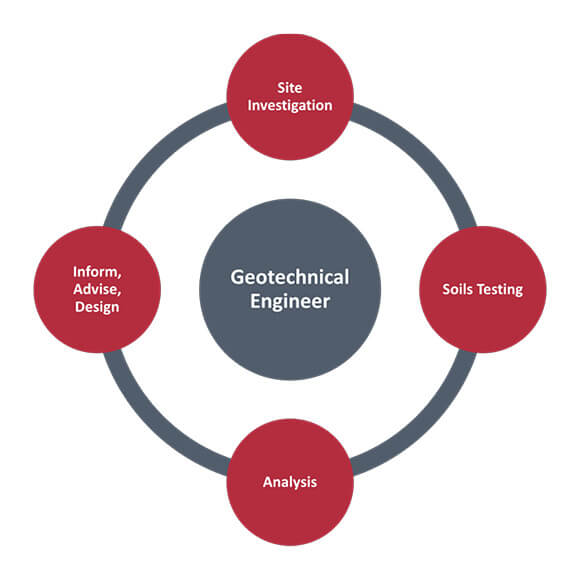4 Simple Techniques For Geotheta
4 Simple Techniques For Geotheta
Blog Article
Little Known Facts About Geotheta.
Table of Contents8 Easy Facts About Geotheta DescribedGeotheta for BeginnersGeotheta Things To Know Before You BuyGeotheta for BeginnersAll about Geotheta

They carry out site examinations, accumulate examples, perform laboratory tests, and analyze information to review the viability of the ground for construction projects - Consulting Engineers. Based on their searchings for, geotechnical designers supply recommendations for structure layout, incline security, retaining frameworks, and mitigation of geotechnical threats. They team up with various other specialists, such as engineers, structural engineers, and construction teams, to guarantee that geotechnical factors to consider are incorporated into the general task design and implementation
By assessing the habits and buildings of soil and rock, they can determine possible geotechnical hazards such as landslides, dirt negotiation, or slope instability. Their competence aids prevent failures or accidents that could jeopardize lives and residential or commercial property. Right here are some detailed responsibilities and responsibilities of a geotechnical designer: Site Investigation: Geotechnical designers conduct site investigations to gather information on subsurface problems.
They interpret the information to recognize the residential properties and behavior of the dirt and rock, including their strength, permeability, compaction features, and groundwater problems. Geotechnical Evaluation and Layout: Geotechnical engineers assess the information gathered during website investigations to examine the stability and suitability of the website for building jobs. They carry out geotechnical estimations and modeling to evaluate factors such as bearing capacity, settlement, slope stability, side planet pressures, and groundwater circulation.
Not known Facts About Geotheta
Foundation Design: Geotechnical engineers play an essential role in designing foundations that can safely support the designated framework. They analyze the dirt conditions and lots demands to figure out the ideal structure kind, such as shallow foundations (e.g., footings), deep foundations (e.g (https://www.dreamstime.com/ianhammond2191_info)., heaps), or specialized methods like dirt renovation. They think about elements such as negotiation limits, birthing ability, and soil-structure communication to develop optimal structure styles
They evaluate building and construction strategies, screen website tasks, and carry out field inspections to verify that the layout suggestions are complied with. If unanticipated geotechnical problems develop, they assess the situation and provide suggestions for removal or adjustments to the design. Threat Assessment and Reduction: Geotechnical designers evaluate geotechnical hazards and risks linked with the project site, such as landslides, liquefaction, or dirt disintegration.

Cooperation and Communication: Geotechnical engineers function closely with other professionals involved in a project, such as engineers, architectural designers, and construction teams. Effective interaction and partnership are necessary to incorporate geotechnical factors to consider into the general job style and construction procedure. Geotechnical engineers provide technical competence, answer inquiries, and ensure that geotechnical demands are fulfilled.
The Definitive Guide for Geotheta
Below are some types of geotechnical engineers: Foundation Designer: Foundation designers focus on making and analyzing structures for structures. They evaluate the soil conditions, lots requirements, and site features to identify the most appropriate structure kind and style, such as shallow structures, deep foundations, or specialized techniques like stack structures.
They assess the factors influencing slope stability, such as dirt residential properties, groundwater problems, and incline geometry, and establish strategies to avoid slope failures and alleviate risks. Earthquake Engineer: Earthquake designers focus on examining and creating frameworks to withstand seismic pressures. They evaluate the seismic threat of a website, review soil liquefaction capacity, and develop seismic style criteria to make certain the safety and resilience of structures throughout earthquakes.
They do area screening, collect samples, and analyze the accumulated data to define the dirt buildings, geologic formations, and groundwater problems at a website. Geotechnical Instrumentation Engineer: Geotechnical instrumentation engineers focus on tracking and determining the actions of soil, rock, and frameworks. They set up and preserve instrumentation systems that keep an eye on variables such as soil negotiation, groundwater degrees, slope activities, and structural displacements to assess performance and provide early cautions of possible issues.
Getting My Geotheta To Work
They perform examinations such as triaxial tests, debt consolidation examinations, direct shear examinations, and leaks in the structure examinations to collect data for geotechnical evaluation and design. Geosynthetics Engineer: Geosynthetics designers focus on the style and application of geosynthetic materials, such as geotextiles, geogrids, and geomembranes. They use these products to enhance soil security, enhance slopes, provide water drainage services, and control erosion.
They tend to be investigative individuals, which means they're intellectual, introspective, and investigative. They wonder, methodical, rational, logical, and sensible. Several of them are likewise social, suggesting they're kind, generous, cooperative, client, caring, useful, empathetic, tactful, and friendly. Does this audio like Get More Information you? Take our complimentary profession test to learn if geotechnical designer is one of your top occupation matches.
In the office setting, geotechnical designers make use of specialized software tools to do estimations, create styles, and examine information. They prepare records, evaluation task specs, interact with clients and employee, and coordinate job activities. The workplace setup gives a helpful setting for study, evaluation, and partnership with various other professionals included in the job.
The Only Guide for Geotheta
They regularly check out job sites to conduct site investigations, examine geotechnical problems, and gather information for evaluation. These visits entail taking a trip to various areas, often in remote or challenging surfaces. Geotechnical designers might execute dirt sampling, conduct examinations, and screen building tasks to make certain that the geotechnical facets of the project are being carried out properly.
Geotechnical designers likewise function in specialized geotechnical labs. In these centers, they carry out experiments, perform tests on soil and rock examples, and assess the engineering residential or commercial properties of the materials. Geotechnical laboratory designers function extensively in these environments, handling testing tools, operating instruments, and videotaping data. They work together with other laboratory personnel to make sure accurate and dependable testing outcomes.
Report this page